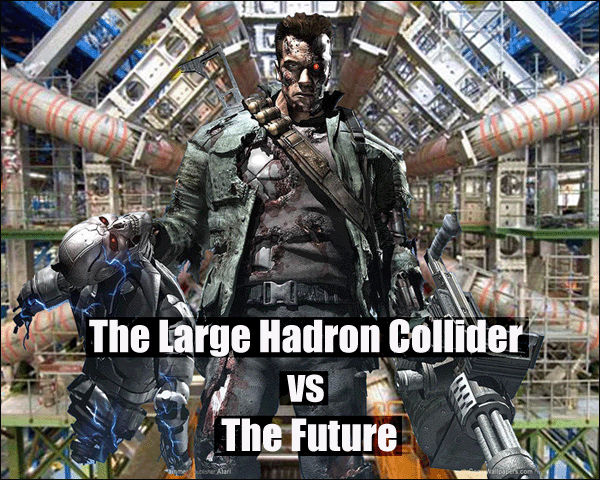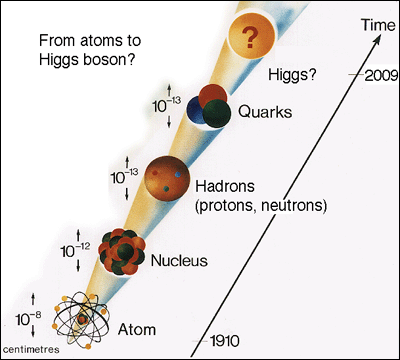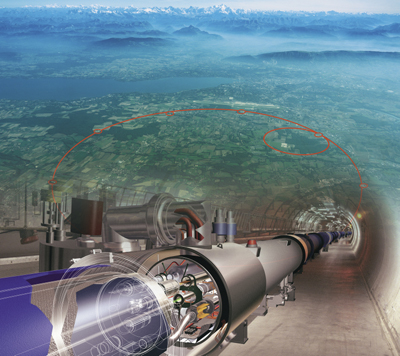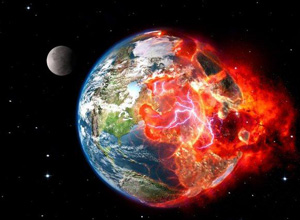 Large Hadron Collider - a collision with the future?
by Gary Vey
When I was younger I used to have this repeating dream. It took place in the town where I grew up and was always in this big old brown house with a distinctive porch. The dream replayed in my sleep over many years. As I got older I decided to leave the house and run to the street corner to read street sign. Maybe the house was real -- something from a distant childhood memory.
The next few times I had this dream I did just that. I ran to the corner and looked up at the street sign. But as soon as I tried to read the letters, they disintegrated and I woke up.
When physicists try to explain this existence, what we call "reality", they try to describe what "stuff" is made of. Over the last century, scientists have discovered that stuff, including our bodies, is made of molecules, atoms and particles.
Not satisfied with that, they have divided particles into smaller things called quarks. But at this small scale, the things that make "stuff" become as illusive as my dream. It's as if the very fabric of our reality is not real at all.
More recently, astronomers have discovered that everything we know of as "stuff" is just 5% of what actually exists. The remaining 95% is called "Dark Matter" which we cannot see or directly measure. Dark matter exists in another dimention -- outside this dream we call "reality."
How to see smaller and smaller particles
So what's inside a proton? Just smash some protons together and break them in to smaller bits. Now you have a variety of smaller particles called quarks.
What's inside quarks? That's why the Large Hadron Collider (LHC) was built.
Protons and neutrons are known as hadrons, particles made from composites of quarks. Quarks are unstable and elusive, like the street sign in my dream. We can only detect them for an instant before they degrade or regroup in another hadron. Smashing quarks together isn't practical. Instead, we can smash the protons together with an even greater force -- so great that it will break apart the hadrons and hopefully also the quarks. This is the theory behind the LHC.
What do the scientists think they will find? The answer is the Higgs boson particle, also known as the "God particle."
What's a "God particle" anyway?
The technical name is the Higgs boson. It's called the "God particle" because physicists think (and hope) it will be the smallest fundamental building block of everything -- a particle that creates all other particles. By understanding how the Higgs boson works we will finally understand how the universe was created.
No one has ever seen or detected a Higgs boson. It's just a theory. If they don't detect it with the LHC then physicists will be left without a theory. They've invested everyhting in its existence.
Some, like Steven Hawking, muse over the possibility that the Higgs boson will not be detected.
How the LHC works
The purpose of this article is not to give a lesson in physics. The technique by which the LHC will smash protons into eachother is as complex as the mechanism itself.
The LHC is the world's largest and highest-energy particle accelerator and is contained in a circular tunnel with a circumference of 17 miles [above], at a depth ranging from 160 to 570 feet underground. It has a 12 foot wide concrete-lined tunnel [below], constructed between 1983 and 1988, was formerly used to house the Large Electron-Positron Collider and crosses the border between Switzerland and France at four points, with most of it being in France. Surface buildings hold ancillary equipment such as compressors, ventilation equipment, control electronics and refrigeration plants.
When the mechanism is fired up, it will begin circulating lead protons in opposide directions inside the huge loop. It will ramp up the velocity and power over time and eventually will enable packets of protons to collide with eachother. Detectors will then look for the illusive Higgs boson particles and record the event.
What's all the worry about?
Frankly, there is always reason to worry about untested technology. Even more so with the LHC because we are dealing with particles on the very edge -- if not beyond -- this physical reality we exist in.
A top official at the LHC says that the titanic machine may possibly create or discover previously unimagined scientific phenomena, or "unknown unknowns" -- for instance "an extra dimension".
"Out of this door might come something, or we might send something through it," said Sergio Bertolucci, who is Director for Research and Scientific Computing at CERN, briefing reporters at CERN Headquarters earlier this week. It's this kind of comment from the top that causes concern about the unknown effects of the accelerator.
One theory is that this collision will compress the opposing protons to an incredibly small yet massive particle -- a mini-black hole. Since this black hole will have an extremely strong gravitational pull it may continue to "swallow" other matter and grow in size. Some scientists have even claimed it could eventually swallow the Earth!
But it was already tested and nothing happened - right?
Well, sort of.
The initial start of the LHC last year never collided any protons. It was only the "test drive" to see if the protons could be made to safely circle the large 17 mile loop. They sent particles clockwise, then counter-clockwise -- but they never got to collide them because of equipment failure.
The press was quick to ridicule those concerned with the potential catastrophe of the LHC experiment and failed to give the facts. This allowed the public to be made to think that the LHC was safe and "not to worry." But those who understand the physics and theoretical dangers of the LHC experiment have not wavered in their opposition.
The real test happened on March 29th. The Large Hadron Collider in Geneva succeeded in colliding subatomic particles at 7 TeV -- three times the highest energy levels previously recorded. Scientists gathered in a room at Caltech and in similar groups around the globe witnessed the achievement at 3:58 PDT. And, yes, the world survived. But this was just half the incredible power that the apparatus will run when it is at full throttle.
"There were cheers in all the control rooms," said Caltech physicist Harvey Newman. "As soon as we get the data, we're analyzing it. ... It's been a long time coming."
The team will attempt to ramp up the power to an amazing 14 TeV by the end of 2012, after some improvements are made to the design. At that power we should know if there really is a "God" (Higgs) particle and if all this worry has been for nothing.
Contact from the future?
Scientists claim the Large Hadron Collider is being jinxed from the future to save the world. Danish physicist Dr Holger Bech Nielsen and Dr Masao Ninomiya from Japan claim the LHC startup has been delayed due to nature trying to prevent it from finding the elusive Higgs boson, or "God particle".
They say their math proves that nature will "ripple backward through time" to stop the LHC before it can detect the God particle, like a time traveller who goes back in time to kill his grandfather, or a plot from movie, Terminator.
"It must be our prediction that all Higgs producing machines shall have bad luck."
The multi-billion-dollar LHC, built over almost 20 years, was set to launch in late 2008 but broke down after it overheated during a test run. The relaunch was pushed back to November 2009 as more parts had to be replaced, and CERN was recently scandalised when a LHC scientist was found to have approached al-Qaeda for work.
This has lead some to reconsider whether nature itself could be against the experiment.
The LHC already features in science fiction plots such as Dan Brown's Angels and Demons and the new TV show FlashForward and has been dubbed a "doomsday device" by the internet conspiracy culture with more fears that it will open black holes.
Last year, Professor Brian Cox of Manchester University told the UK Telegraph that LHC scientists had received threatening emails and phone calls demanding that the experiment be halted.
But it will not be halted and we will all hold our breath when the first proton collision takes place -- unless some timely accident happens. "I'll be back!"
Speak of the Singularity -- It's going to be delayed again!
The Large Hadron Collider (LHC) must close at the end of 2011 for up to a year to address design issues, according to an LHC director.
Dr Steve Myers told BBC News the faults will delay the machine reaching its full potential for two years.
The atom smasher reached world record collision energies in the end of March 2010 at 7 trillion electron volts.
But joints between the machine's magnets must be strengthened before higher-energy collisions can commence.
The Geneva-based machine only recently restarted after being out of action for 14 months following an accident in September 2008.
Dr Myers said: "It's something that, with a lot more resources and with a lot more manpower and quality control, possibly could have been avoided but I have difficulty in thinking that this is something that was a design error."
He said: "The standard phrase is that the LHC is its own prototype. We are pushing technologies towards their limits."
"You don't hear about the thousands or hundreds of thousands of other areas that have gone incredibly well.
"With a machine like the LHC, you only build one and you only build it once."
The CMS detector can be put through its paces at reduced power
He said the second problem is not with the most complex technology but involves the copper sheaths around the superconducting joints in the tunnel.
The copper sheaths are a failsafe mechanism designed to take up the current if one of the magnets in the Large Hadron Collider warms up - an incident known as a "quench".
The 2008 accident caused one tonne of helium to leak into the tunnel and resulted in a series of "quenches" and a 40 million Swiss franc repair bill.
Engineers believe the machine is now safe to run at 7 trillion electron volts (TeV) for a while, but are anxious to avoid another breakdown in the future with more power.
So they have taken the decision to run the machine for 18 to 24 months at half-maximum power before switching it off for a year to carry out improvements to the 27km tunnel.
Dr Myers said the decision was taken jointly with the physicists working on the four giant particle detectors on the LHC.
He said they appreciate the chance to test their own equipment while the machine is running at half its maximum power.
Collisions at enormous energy
The Large Hadron Collider sends beams of protons in opposite directions around the tunnel at close to the speed of light. These cross and collide, smashing into each other with enormous energy.
The ultimate aim is to collide particles head on at 14TeV to recreate the conditions in the moments after the Big Bang.
Scientists hope they will see new subatomic particles in the debris and gain insights into how the universe came into being, billions of years ago.
The machine is buried 100m below the French-Swiss border.
Cern officials say running the LHC at 7TeV will enable physicists to explore another secret of the universe, namely the nature of the "dark matter" that accounts for most of the mass in the observable universe.
|
 A classic example of this illusive phenomenon is the Heisenberg Uncertainty Principle which, in quantum mechanics, states that the position and momentum of particle cannot both be known. That is, the more precisely one property is known, the less precisely the other can be known. It is as if by observing one property we are changing the other.
A classic example of this illusive phenomenon is the Heisenberg Uncertainty Principle which, in quantum mechanics, states that the position and momentum of particle cannot both be known. That is, the more precisely one property is known, the less precisely the other can be known. It is as if by observing one property we are changing the other. Scientists like to make analogies. They tell us an atom is like a watch. Without opening it up and looking at the cogs and gears it's impossible to understand how it works. Their method of solving the problem is to smash two watches together, with great force, and let the tiny bits and gears fall out where they can be observed and measured. That's what "atom smashers" did and we learned that the atomic elements were composed of electrons, protons and neutrons.
Scientists like to make analogies. They tell us an atom is like a watch. Without opening it up and looking at the cogs and gears it's impossible to understand how it works. Their method of solving the problem is to smash two watches together, with great force, and let the tiny bits and gears fall out where they can be observed and measured. That's what "atom smashers" did and we learned that the atomic elements were composed of electrons, protons and neutrons.

 Consider that Albert Einstein's model of the universe, which we currently hold as fact, states that nothing can exceed the speed of light. With the LHC we are told that, prior to their head-on collision, each proton of lead will be accelerated to 99.9999991% the speed of light! The combined impact of these protons will then be approximately two times the velocity of light. What will result from this combined velocity and energy -- besides the Higgs boson?
Consider that Albert Einstein's model of the universe, which we currently hold as fact, states that nothing can exceed the speed of light. With the LHC we are told that, prior to their head-on collision, each proton of lead will be accelerated to 99.9999991% the speed of light! The combined impact of these protons will then be approximately two times the velocity of light. What will result from this combined velocity and energy -- besides the Higgs boson? Just as it was re-started in November, an aluminum casing containing the sensitive coolents needed to produce super-conductivity in the loop suddenly overheated and the mechanism had to be aborted. The culprit was a small piece of bread believed dropped on the casing by a passing pigeon!
Just as it was re-started in November, an aluminum casing containing the sensitive coolents needed to produce super-conductivity in the loop suddenly overheated and the mechanism had to be aborted. The culprit was a small piece of bread believed dropped on the casing by a passing pigeon!